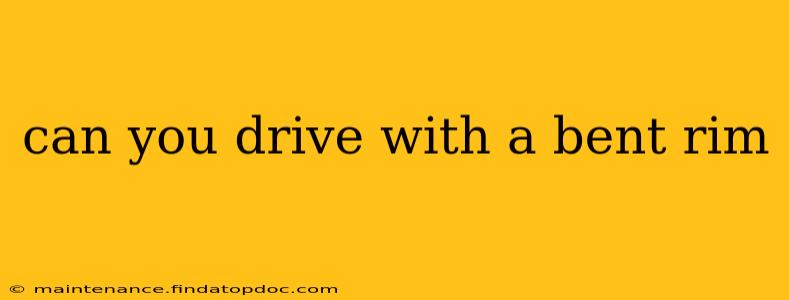Can You Drive With a Bent Rim? The Risks and Realities
Driving with a bent rim is a risky proposition, and the answer is a qualified no. While you might be able to drive a short distance on a slightly bent rim, doing so carries significant risks to your safety and the health of your vehicle. This article will explore the dangers and help you understand the best course of action if you suspect you have a bent rim.
What Happens When a Rim Bends?
A bent rim is a structural compromise. The wheel's integrity is weakened, potentially leading to several serious problems:
- Tire damage: A bent rim puts uneven pressure on the tire, causing it to bulge, wear unevenly, and potentially even lead to a blowout. This is incredibly dangerous, especially at higher speeds.
- Vibration and handling issues: The bent rim will cause vibrations felt throughout the car, making driving uncomfortable and potentially affecting your ability to control the vehicle. This can be particularly dangerous in adverse weather conditions.
- Wheel bearing damage: The uneven pressure and vibrations can put extra strain on wheel bearings, leading to premature wear and tear, and even catastrophic failure.
- Suspension damage: The constant jarring and vibrations can transfer to other parts of the suspension system, potentially causing damage to struts, shocks, and other components.
- Brake issues: Severe bending can interfere with the proper function of your brakes, leading to reduced braking power or uneven braking.
How Can You Tell if Your Rim is Bent?
Identifying a bent rim can be challenging, but there are several signs to look out for:
- Visible damage: Obvious bends or cracks in the rim are easy to spot.
- Vibrations: Feel significant vibrations in the steering wheel, especially at higher speeds. This is a major warning sign.
- Uneven tire wear: If your tires are wearing unevenly, a bent rim could be the culprit. Check the tread depth across the entire tire.
- Pulling to one side: If your car pulls noticeably to one side while driving, it might indicate a problem with a bent rim or other suspension component.
- Unusual noises: Listen for any unusual thumping, banging, or scraping sounds when driving.
How Far Can You Drive on a Bent Rim?
Driving on a bent rim, even a slightly bent one, should be limited to the shortest distance possible to a safe location for repair or replacement. This might be your home or a nearby tire shop. Avoid highway driving at all costs. The higher speeds and potential for a blowout make this extremely dangerous.
Can You Repair a Bent Rim?
Sometimes, a slightly bent rim can be repaired by a professional wheel repair shop. However, severely bent or cracked rims should be replaced. Repair is often only cost-effective for minor bends; extensive damage usually makes replacement a more sensible option.
What Should You Do if You Have a Bent Rim?
- Drive slowly and carefully: Avoid sudden braking or maneuvers.
- Reduce speed: Drive at significantly reduced speed to minimize the impact on the tire and other components.
- Get to a safe location: Pull over as soon as possible in a safe location and call for roadside assistance or a tow truck.
- Have the rim inspected: Take your vehicle to a qualified mechanic or tire shop for a thorough inspection and recommendation for repair or replacement.
Driving with a bent rim is not a risk worth taking. The potential for serious damage to your vehicle and, more importantly, a significant safety hazard to yourself and others, far outweighs any inconvenience of getting it repaired or replaced promptly. Your safety is paramount.
